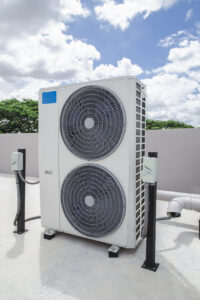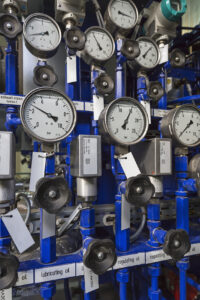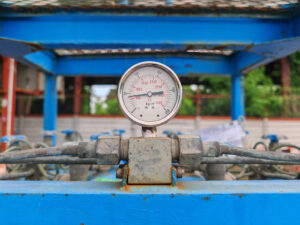
To carry out pressure detection, a measurement system is actually needed to realize it. In order to achieve an accurate measurement, in addition to correct selection and verification (calibration) of the instrument, attention must also be paid to the correct installation of the entire system. If only the shock-resistant pressure gauge itself is accurate, its indication cannot fully represent the actual parameters of the measured medium, because the error of the measurement system is not equal to the error of the instrument. The correct installation of the system includes the opening position of the pressure tap, the reasonable laying of the connecting pipe and the correct installation position of the instrument.
1. Selection of the position of the pressure port
(1) Avoid being in the area where the pipeline is bent, bifurcated and the stream forms eddy currents.
(2) When there is a protruding object (such as a temperature measuring element) in the pipeline, the pressure tap should be taken in front of it.
(3) When pressure must be taken near the regulating valve, if the pressure taking port is in front, the distance from the valve should not be less than 2 times the pipe diameter; if the pressure taking port is behind, the distance from the valve should not be less than 3 times Pipe diameter.
(4) For a wide container, the pressure tap should be in an area where the fluid flows smoothly and there is no vortex. In short, the position of the pressure tap determined in the process flow should be able to ensure that the selected process parameters are measured.
2. Laying of connecting pipes
The horizontal section of the connecting pipe should have a certain slope to facilitate the removal of condensed liquid or gas. When the measured medium is gas, the pipe should be inclined towards the pressure tap; when the measured medium is liquid, the pipe should be inclined towards the pressure measuring instrument; when the measured parameter is a small differential pressure value, it should be inclined The degree can be slightly larger. In addition, if the duct is at the upper and lower corners, according to the medium in the duct, a device for draining condensed liquid should be installed at the lowest point or an exhaust device at the highest point to ensure that condensation does not accumulate in the duct for a long time. Liquid or gas affects the accuracy of the measurement. Condensed liquid or gas should be discharged regularly.
(1) The pressure gauge should be installed perpendicular to the horizontal plane;
(2) The orientation of the instrument should face the direction that is convenient for operation and observation;
(3) The end of the pressure source component should not exceed the inner wall of the equipment or pipeline;
(4) The pressure on the same pipeline is the first, the temperature is the back, and the hole distance is greater than or equal to 200mm.
Note: The measuring points of the measuring protection and the automatic control instrument are not allowed to use the same measuring hole. Mainly to avoid mutual influence during daily maintenance, so that the protection and interlocking instruments are affected, thereby interlocking other equipment to mediate.
(5) When detecting turbid materials such as dust, solid particles or sediments, the source components on vertical and inclined equipment and pipelines should be installed obliquely upwards, and the horizontal pipelines should be installed along with the material flow at an acute angle.
3. General installation attention
(1) Under normal circumstances, the installation height should be flush with people’s line of sight, about 1.5m. For high-pressure pressure gauges, the installation height should be higher than the head of ordinary people.
(2) When measuring the pressure of liquid or steam medium, the error caused by the liquid column should be avoided. The pressure gauge should be installed at the same level as the pressure tap, otherwise the displayed value of the pressure gauge must be corrected.
(3) At the connection of the pressure gauge, suitable materials should be selected as the sealing gasket according to the measured pressure and the nature of the measured medium to prevent leakage.
(4) The thickness of the pressure guiding tube is suitable, generally, 6-10mm, and the length is as short as possible, otherwise it will cause measurement delay.
(5) The pressure gauge should be installed at room temperature as much as possible, the relative humidity is less than 80%, the vibration is small, the dust is less, and there is no corrosive substance. For the electric pressure gauge, electromagnetic interference should be avoided as much as possible.
(6) When two pressure gauges are installed side by side, the distance between the instrument shells should be kept 0-50mm.
(7) The installation position of the pressure gauge should be avoided where there are frequent mechanical operations, so as not to damage the pressure gauge when operating other equipment. Such as manually operated valve handle.
(8) To make holes in the pressure pipeline, a mechanical hole method (electric drill or hand drill) must be used
Note: The upper hole of the wind pressure pipe can be cut by gas. After cutting, the hole is rounded and filed.
(9) A shut-off valve should be installed between the pressure port and the pressure gauge for use in maintenance. The shut-off valve should be installed near the pressure tap.
4. Special media installation
(1) When measuring the pressure of high temperature (above 60℃) fluid medium, in order to prevent direct contact between the heating medium and the elastic element, a U-shaped tube or coiled tube should be installed before the pressure gauge to avoid the measurement due to temperature changes. Accuracy and impact of elastic components.
Note: When measuring the pressure of a high-pressure fluid medium, the pressure gauge case should face the wall or a place where no one passes through during installation to prevent accidents.
(2) When measuring the pressure of corrosive media, in addition to selecting a pressure gauge with anti-corrosion capability, an isolation device should be installed, and the isolation fluid in the isolation tank should be used to isolate the measured medium from the elastic element.
(3) When measuring pressure with severe fluctuations (such as the outlet pressure of pumps and compressors), a needle valve and a buffer should be installed before the pressure gauge, and a damper should be installed if necessary.
(4) When measuring the pressure of a medium that is viscous or easy to crystallize, an isolation tank should be installed on the pressure taking device so that the tank and the pressure guiding tube are filled with isolation liquid, and heat preservation measures can be taken if necessary.
(5) When measuring the pressure of the dust-containing medium, it is best to install a dust collector after the pressure taking device.
In short, according to the different properties of the measured medium, corresponding measures such as heat prevention, corrosion prevention, antifreeze, anti-blocking, and dust prevention must be taken.



